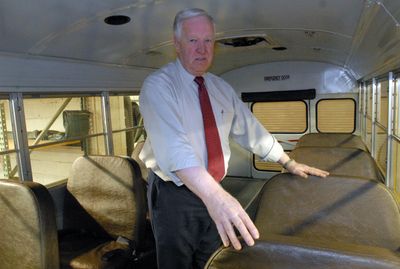Rules adding safety features to all new school buses

The federal government last week issued new regulations to increase the safety of children in school buses.
Higher seat backs are required on new full-sized buses, while seat belts are mandated on new buses smaller than 5 tons.
The U.S. Department of Transportation stopped short of requiring seat belts on larger school buses.
The regulations are not expected to affect local districts, which have been meeting increased safety requirements as technology and study findings point the way to greater protection.
Melanie Rose, public information officer for the Central Valley School District, said the district’s new buses already are equipped to meet the latest federal standards. They have seat backs that are at least 24 inches high, and smaller buses also come with three-point seat belts. The district operates 12 of the small buses.
In the Mead School District, which covers a broad swath of Spokane County, buses log more than 1 million miles a year.
Jack Lewis, transportation director, said the higher seat backs increase protection in a front-end crash, and are large enough to accommodate belts with shoulder harnesses if that is deemed prudent. Also, the higher backs are padded, adding protection to passengers thrown forward in a crash.
Lewis said the regulations follow a long debate on whether larger buses are safer with or without seat belts, and that studies are inconclusive.
Larger buses absorb shock better, reducing the risk of injury, and the seat configuration keeps children in a relatively confined space. With belts, children could be trapped if the bus lands on its side, leaving some passengers suspended in the air.Seat belts have the added problem of reducing capacity from three passengers to two on each side of a row.
The new federal regulations allow local jurisdictions to install seat belts on larger buses if they want.
“After considering all available information …we cannot conclude that a requirement for seat belts on large school buses will protect against an unreasonable risk of accidents or an unreasonable risk of death or injury in an accident,” according to the new rule issued Wednesday. “Whether the same conclusion can be made by a state or local jurisdiction is a matter for local decision-makers and we encourage them to make the decisions most appropriate for their individual needs to most safely transport their students to and from school.”
In a press release, Transportation Secretary Mary Peters said, “Even though riding in school buses is the safest form of travel in America today, any accident is still a tragedy. Taken together, these steps are designed with a single purpose, making children safer.”
The new rules came as a result of a 2006 bus accident in Huntsville, Ala.
Who foots the bill?
A new study conducted on Initiative 985 shows that residents outside of the greater Seattle area would subsidize traffic congestion improvements – largely in and around Seattle – to the tune of $180 million over five years.
I-985 would divert some existing taxes, including a portion of sales taxes collected on new cars, to fund a program to reduce traffic congestion around the state in what is estimated to be a nearly $600 million program over five years.
Sightline Institute, a research firm, said the initiative on this fall’s ballot would siphon tax money from Central and Eastern Washington to benefit motorists on Puget Sound roadways.
Safety reminder
This week is National School Bus Safety Week, and the company that provides transportation for Spokane Public Schools is reminding motorists to be careful around schools and school buses.
Durham School Services is recommending that drivers:
•Slow down, especially when driving on neighborhood streets and around school zones;
•Always stop when you see flashing red lights or the stop arm is extended on a school bus; and
•Be especially careful when backing out of your driveway or leaving a parking garage in case children are near.
Openings and closures
Work on the U.S. Highway 2 bridge over Deep Creek in western Spokane County was completed earlier this month.
A traffic light was set up to allow for one-way traffic on the bridge during extensive reconstruction of the sidewalk, guardrail, pavement contour, approaching abutments, columns and girders. Water had been washing earth from around concrete approach slabs beneath the bridge.
On Tuesday, the Interstate 90 westbound Thor/Freya on ramp and the westbound Altamont off ramp will be closed starting at 10 a.m. for a few hours to repair a light pole.
The city of Spokane has completed its spring and summer street improvement projects, including late-scheduled projects on Hatch Road and Driscoll Boulevard.